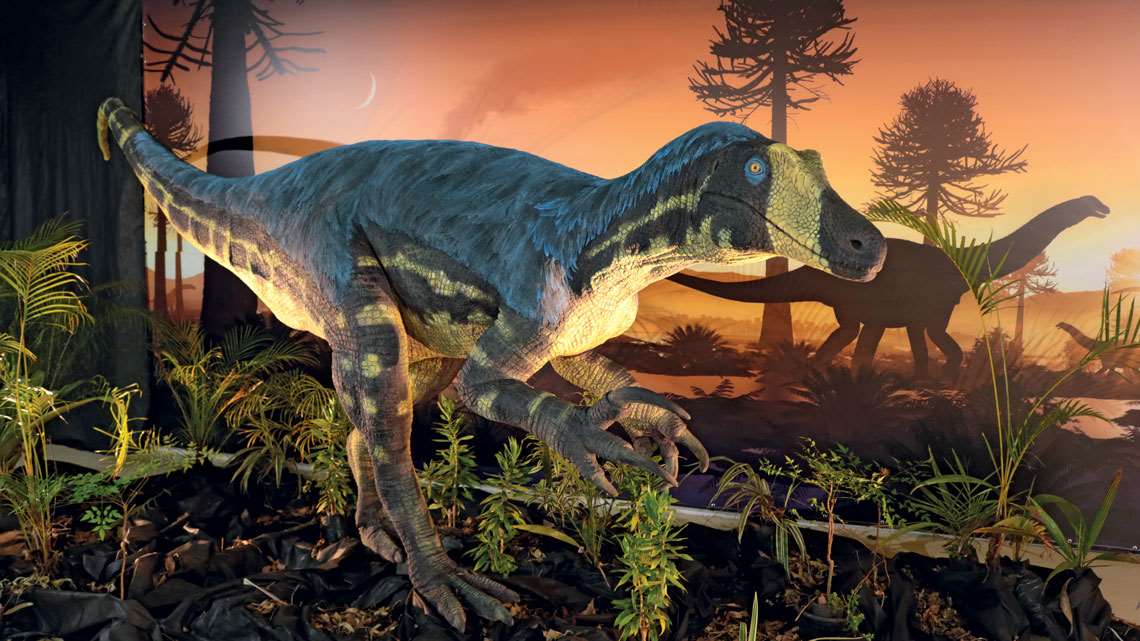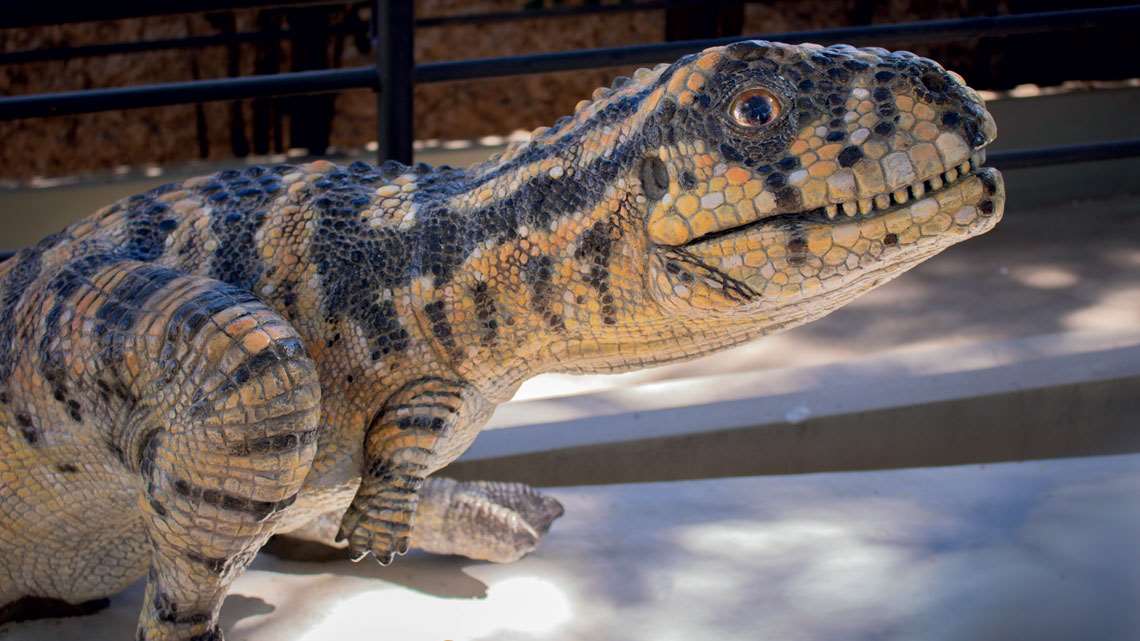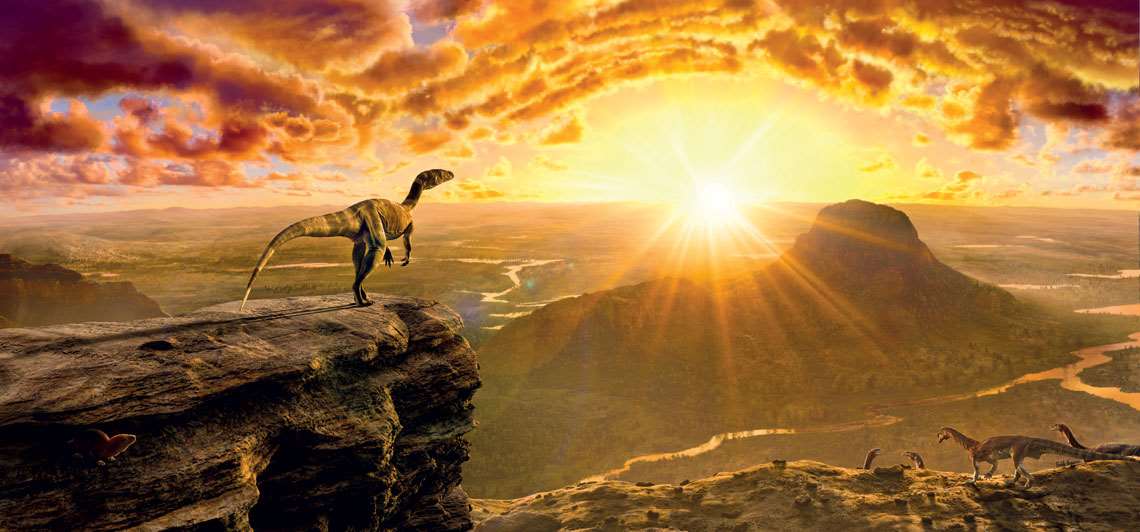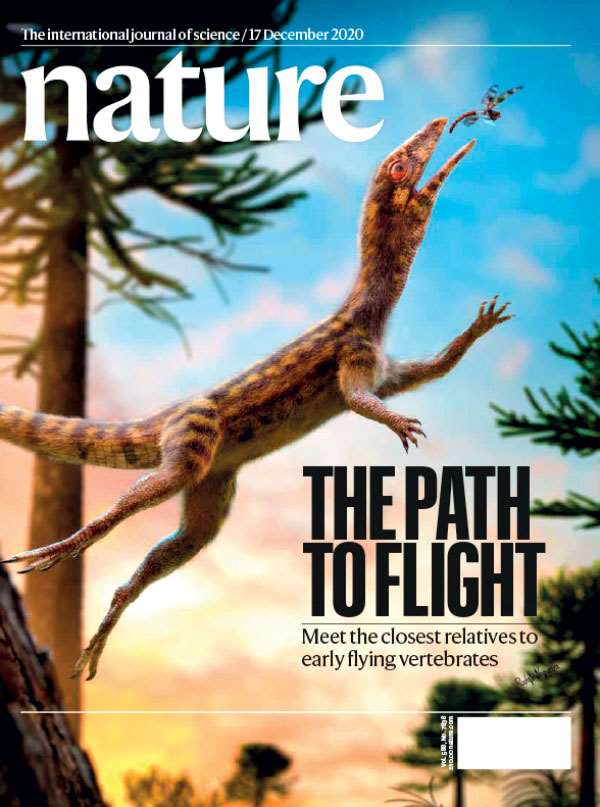Rodolfo Nogueira has had a passion for dinosaurs since he was a child. Learning how to draw them has given him something of a superpower: the ability to bring animals from the distant past back to life—or so to speak.
In his hometown of Uberaba, in the Minas Triangle, southeastern Brazil, excavations for construction work often unearth ancient dinosaur fossils. Throughout the city, dinosaur replicas created with vivid precision, drawing from a mix of imagination and scientific evidence, are turning city squares into geosites that together will form a larger geopark (see Pesquisa FAPESP issue nº 308).
In November, Nogueira won a prestigious international prize devoted to his branch of art, the Lanzendorf National Geographic Paleoart Prize, in the 2D Art category. This was his third Lanzendorf prize—he had previously received one in 2015 in the Scientific Illustration category, and in 2018 in the Scientific Animation category. At age 35, he has won 17 awards for his work so far, including 13 international prizes. In this interview, he shares with Pesquisa FAPESP how he learned to reconcile his passion for paleontology with art, and how he developed a method for inferring what animals were like that lived millions of years ago, often with nothing more than a claw to go by.

Rodolfo Nogueira
… such as this 6-meter megaraptorRodolfo NogueiraWas the prize you recently won awarded for a specific drawing?
Yes, for an image depicting the dawn of the dinosaur era 230 million years ago, in southern Brazil, featuring two of the most ancient known dinosaurs, Saturnalia and Pampadromaeus. It was an illustration I did for a book that won the Jabuti award for the best kids’ book in 2018, O Brasil dos dinossauros [A land of dinosaurs]. The book, published by Marte, was a collaboration with Luiz Eduardo Anelli, a paleontologist at USP [University of São Paulo]. The Lanzendorf prize is organized by the largest paleontology association in the world—the Society of Vertebrate Paleontology—with funding from the National Geographic Society. It has certainly been a highlight in my career, and I dare say it will help to raise the profile of Brazilian science on the international scene—the broader paleontology community is being exposed to an illustration representing the emergence of dinosaurs in a Brazilian landscape, with animals that arose in present-day Brazil, illustrated by a Brazilian artist, as a result of Brazilian research (see Pesquisa FAPESP issue nº 279).
Your line of work would be a dream job for many children, and was for you. How did you turn your dream into reality?
Llewellyn Ivor Price (1905–1980), a paleontologist born in southern Brazil to American parents, returned here in the 1930s and once came across children playing bocce with a dinosaur egg in Uberaba. So he began to explore the region and at first sent his fossil finds to Rio de Janeiro until, in 1993, a museum was established in a rural district called Peirópolis, about 20 kilometers from my hometown. When I was 6 years old, I tagged along with a school excursion to the museum—the bus driver was a relative of my grandmother’s and took me along. To my young eyes, they looked like dragons with crystal bones. I was so fascinated that I wanted to live there. This sparked a passion for dinosaurs that so many children have, but which for me lasted into adulthood. When I was 11 years old, my mother enrolled me in a drawing course. I had a lot of anxiety, borderline autism, and frequent headaches, and my mother thought it could be good for me. Little did she know that art would end up becoming my profession, and would equip me to turn my imagination into reality.
Were you obsessed with drawing dinosaurs from a young age?
I felt that anything I could draw could be mine to keep. If I wanted to gain an understanding of something, I would draw it. I soon realized that I didn’t want to be a paleontologist; I just wanted to draw dinosaurs. I enrolled in the school of industrial design at the Bauru campus of São Paulo State University (UNESP) and took a scientific initiation course in paleoart. The field was very much incipient: there were very few paleoartists in Brazil, and even elsewhere, there were no textbooks about how to reconstruct dinosaurs using computer graphics. I developed a detailed methodology, like a recipe, to guide artists in making better reconstructions. This application of design principles to paleontology is now known as paleodesign.
When I was 11 years old, my mother enrolled me in a drawing course that equipped me to turn my imagination into reality
What was your method?
I combined design planning—a step-by-step, goal-oriented process of design—with cutting-edge art techniques and the most recent scientific discoveries. I would essentially analyze the fossil and deduce as much information as I could about the ancient animal. If any parts had not been preserved, I would find similar animals to fill the gaps and rebuild the skeleton. I can then analyze the muscle attachment points on the bones, compare them to other animals, and build the muscle structure. Once the animal’s overall shape has been defined, I reconstruct the skin based on present-day animals that are similar in appearance, diet or habitat. This allows me to infer the animal’s camouflage patterns and texture. We then reconstruct the environment on the basis of the plants found in the sediment, along with other parameters. We arrive at a point where we can confidently say: to the best of our current knowledge, this animal is as realistic and true a representation of the original as possible.
These highly detailed reconstructions are often made from a single tail or finger bone, or a tooth. To what extent do they draw on science and on imagination?
If you want to photograph the past, you use your imagination for a camera. The camera’s sensor is your pencil, paints, clay or computer graphics, but the lens is science. Theoretically, I could imagine any skin color and pattern in reconstructing a dinosaur, because that isn’t preserved in the fossil record. But we can look at the pigment patterns in present-day animals to deduce the patterns of their extinct relatives. For example, the only pigment that mammals produce is melanin. So it’s fairly safe to imagine that a giant sloth will be more likely to have black or white fur than yellow fur with pink polka dots. So science guides the imagination we use to fill in the gaps.
Where did you get your training in paleontology?
From my friendship with specialists and courses I took in paleontology, geology, and vertebrate zoology. I’ve studied anatomy, I’ve dissected countless animals, I’ve even been attacked by an alligator—thankfully with no harm done. The learning process was incredible. I’ve also read a lot on the subject.

Rodolfo Nogueira
A reconstruction of an Abelisaurus hatchling installed at the Santa Rita geositeRodolfo NogueiraDo you work with paleontologists?
At first I worked on my own. I would do my own research, occasionally consulting a paleontologist. But now I work for them, and typically produce the first picture they have of a new species. The researchers provide the information they have, and then I gradually learn about the animal I’m recreating, and every day new discoveries are made that change everything. My dinosaurs will always be wrong at first, because fresh information will always lead to a different reconstruction.
You produce models with detailed scales or skin textures. How is this possible?
It is a science-based chimera, so to speak. We have preserved skin from several dinosaur species, and furs from giant sloths. Some dinosaurs look as if they encountered Medusa and became petrified, as in the Greek legend: they are intact, three-dimensional, and have well preserved skin details. We can also draw inferences from present-day animals. There are certain patterns that are similar across different animals. For example, scales are always smaller at the joints, where the skin flexes more, and larger where greater protection is needed. These patterns inform my choice of scale size, distribution, and shape.
Have you had the opportunity to see fossil finds firsthand in the field?
Here in Uberaba they’re often found right in the middle of the city. When developing a gated community, they found two 15-meter-long dinosaurs within 2 minutes’ walking distance from the central town square. They called me over, and I was delighted to find a field full of animals. I filmed the site, watched them dig out the fossils, and captured them in drawings. In another downtown area, they found a fossil near a sidewalk, and I had the opportunity to watch them excavate the fossil then build a town square around it.

Rodolfo Nogueira
In this award-winning image, a Pampadromaeus is shown facing the sunrise 230 million years ago, as Saturnalia descend a slope beneathRodolfo NogueiraYou’re helping to build a dinosaur square in Uberaba, aren’t you?
Yes, we’ve finished the square, now called the Santa Rita geosite. We’ve already installed reconstructions of two nestlings and a skeleton. We’ve set up another dinosaur in a neighboring square, and one month ago I completed a 6-meter dinosaur that is temporarily being showcased in an exhibition at a local shopping mall. It will then be installed at another square. Four geosites have already been completed, and many more will be revitalized in the near future.
How did this opportunity first present itself?
It’s been a childhood dream of mine. Around six years ago, Luiz Carlos Borges Ribeiro, a geologist who served as head of the Uberaba Dinosaur Museum for more than 20 years, and now heads the geology department at the Federal University of Triângulo Mineiro, realized that Uberaba had the potential to become a geopark of sorts, and wrote up a doctoral thesis describing his ideas. Around that same time, a professor at another university noticed an odd-looking rock on a slope in a downtown area of the city, and thought it looked like a fossil: it was oval-shaped and about 15 centimeters long. Ribeiro confirmed it was a fossil and asked me to design a city square at the site. Last year we were awarded the funding to build it. When we excavated the site, we discovered that it was a humerus—a long bone of the upper limb—of one of those large, thick-necked dinosaurs. It had died there more than 80 million years ago. The place that has now become a city square used to be a wooded area.
I understand that you plan to create sites like these throughout the city to attract paleontological tourism.
Yes, a geopark. These sites have a high geological, educational, and entertainment value. People also visit Uberaba for religious reasons, wanting to see the hometown of [the spiritist medium] Chico Xavier and the many historical churches we have here. We also grow grain crops, and breed the most expensive cattle in the world, of the Zebu variety—the world’s largest Zebu exhibition is held here. Uberaba’s economy revolves around agriculture, religion, and paleontology.

Reproduction
The illustration was featured on the front cover of Nature in December 2020ReproductionCould you describe the geopark you’re developing?
It’s a macro urban planning project that will create multiple tourist sites throughout the region. We currently have 4 sites, and soon we’ll have 16. But we’ll still need to file a geopark application with UNESCO [United Nations Organization for Education, Science, and Culture], and there’s still lots of work to be done before we can do so.
The books, videos, and other materials you produce, for both adults and children, draw attention to your field. Can this help to drive further discoveries?
Yes, it’s a virtuous cycle. We encourage more children to become researchers, we can attract more funding for research, and this means that more paleoartists will be needed. When I first began in the field, paleontology professors all had vivid drawings of dinosaurs in their class slides, but none of them wanted to pay for them. They forgot that many of them had gotten into paleontology because of the paleoart they saw in a book, movie, or museum. Now they are more appreciative of the value of paleoart. The chances of their paper being featured on the front cover of Nature (see Pesquisa FAPESP issue no. 299), for example, will be higher if it is illustrated with paleoart. If any of the children I’ve taught go on to become paleoartists, I’d be thrilled.


